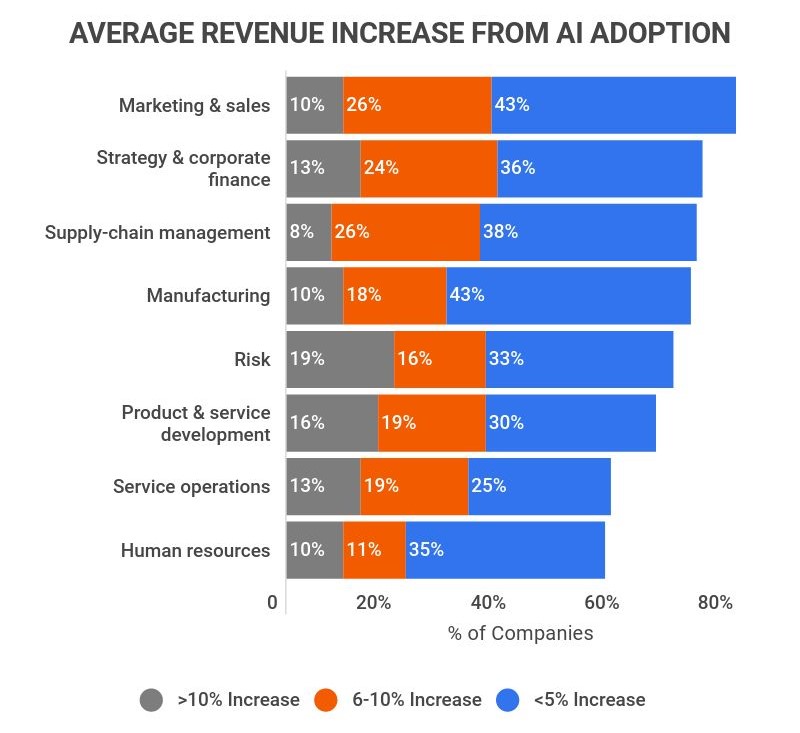Emerging technologies have caused a major shift in the outsourcing industry, drastically affecting how organizations interact with external partners. By streamlining repetitive tasks and minimizing dependency on manual labor, the integration of artificial intelligence, automation, and machine learning has ushered in a new era of efficiency. This reduces costs and speeds up service delivery, making outsourcing more appealing for traditionally labor-intensive tasks.
According to Oracle’s research on Emerging Technologies, 84% of surveyed organizations use at least one emerging technology in production today. In the same survey, 74% agreed that intelligent automation will be critical to keep pace with rapidly shifting regulations within the next five years. These statistics highlight the extensive impact of new technologies on present business operations, indicating a strategy shift toward technological integration. This emphasizes the transformative potential of these innovations, serving as catalysts for efficiency and strategic imperatives for businesses navigating the era of constant change and regulatory flux.

Artificial Intelligence (AI) in Outsourcing

Automating repetitive and rule-based tasks is one of the most significant impacts of AI in outsourcing. AI-powered systems can perform routine tasks more accurately and quickly, improving productivity and cost efficiency. This automation frees human workers to focus on more complex and creative tasks, improving overall work quality.
AI-powered chatbots and virtual assistants have also become essential to customer service outsourcing strategies. These technologies allow organizations to deliver immediate, personalized customer assistance, boosting user experiences and satisfaction. The capability of AI in natural language processing and contextual understanding significantly enhances communication, rendering it a valuable tool in customer-facing outsourcing services.
Blockchain Technologies
One key benefit of blockchain technology is increased transaction security and trust. The decentralized ledger system of blockchain ensures immutable and transparent records, lowering the possibility of fraud or tampering. This function is especially useful in outsourcing contracts and transactions, where secure and verifiable records are essential.
Blockchain-powered smart contracts automate and execute agreements based on predefined conditions. It simplifies outsourcing operations, eliminating the need for intermediaries and increasing operational efficiency. It also reduces disputes by executing transactions only when predefined conditions are met, ensuring greater reliability and agreement adherence.
Moreover, blockchain’s traceability and transparency attributes are helpful in supply chain management in outsourcing. It enables real-time tracking of goods or services, enhancing accountability and efficiency across the supply chain. This transparency increases confidence among parties involved in outsourcing agreements, reducing disputes and improving collaboration.
Internet of Things (IoT)
The Internet of Things has emerged as a game-changer in outsourcing, offering a new dimension of connectivity and data-driven insights. By embedding sensors and devices in physical assets, businesses can collect real-time data on performance, usage trends, and maintenance needs. This method enables predictive maintenance, minimizing downtime and increasing the overall efficiency of outsourced operations.
IoT also is critical in boosting visibility and traceability in supply chain management. Connected devices enable continuous monitoring of the whole supply chain, from production to transportation and delivery. It improves logistical efficiency, reduces delays, and creates a more responsive and simplified outsourced ecosystem.
Additionally, IoT-generated data enables data analytics and predictive modeling, offering informed decision-making in outsourcing. The insights from connected devices allow businesses to predict trends, identify areas of improvement, and make strategic decisions that benefit outsourced operations.
Robotic Process Automation (RPA)
RPA includes using software robots or “bots” to automate repetitive and rule-based tasks. This means that basic business processes can be completed quickly and precisely, freeing up human resources to focus on more difficult and strategic parts of their roles.
RPA’s ability to drastically reduce operating expenses is one of its main benefits in outsourcing. Because bots can operate non-stop for 24 hours a day, they can do more tasks quickly and efficiently. This speeds up turnaround times and lowers costs for businesses involved in outsourcing. Moreover, RPA helps enhance accuracy and compliance. Bots guarantee consistency and reduce the risk of errors in tasks like data entry, invoice processing, and other similar activities by following pre-established rules and processes.
RPA is also a flexible option for outsourcing companies due to its scalability. As business volumes change, RPA enables easy adjustment of robot capacity, enabling flexibility and adaptability in addressing the dynamic needs of outsourcing clients.
Augmented Reality (AR) and Virtual Reality (VR)
Augmented Reality improves real-world environments by incorporating digital information or visuals into physical surroundings. AR can be used in remote help scenarios in outsourcing, allowing experts to guide on-site personnel through tasks using virtual annotations and instructions. This reduces the need for physical presence, enabling cost-effective and real-time collaboration.
Conversely, virtual reality produces fully immersive digital environments. VR can be used in training programs in outsourcing, where employees can mimic complex tasks or scenarios in a risk-free virtual environment. This shortens the learning curve and reduces the need for physical training facilities, making training more scalable and accessible.
The impact of AR and VR on outsourcing is particularly evident in product design and prototyping. Remote teams may work in virtual environments, visualizing and revising designs in real-time. This shortens the product development cycle and facilitates global collaboration among geographically distant teams.
Data Analytics and Predictive Modeling
Data Analytics is the systematic analysis of massive datasets to generate relevant insights. Businesses can thoroughly understand trends, patterns, and performance metrics in their operations using advanced analytics tools and approaches. Predictive Modeling expands data analytics by applying statistical algorithms and machine-learning techniques to forecast future trends and outcomes. This proactive strategy enables companies to make decisions with a forward-thinking mindset, reducing uncertainties and disruptions.
The value of big data analytics and predictive modeling in outsourcing is significant. From supply chain optimization to customer relationship management, they enable companies to streamline processes, cut costs, and improve performance. With the integration of these technologies, data-driven decision-making becomes more agile and precise. Outsourcing providers can personalize their services by analyzing patterns and preferences of specific client needs, enhancing customer satisfaction and retention.
The Dynamic Workforce in the Era of Emerging Technologies
The significance of emerging technologies in the business world goes beyond operational improvements. Intelligent algorithms are streamlining coding processes and automating testing in software development, reshaping traditional business models. The ability to adapt business models to embrace new technologies becomes a strategic advantage, promoting innovation and enhancing competitiveness.
As technology automates routine tasks, the workforce can engage in higher-order thinking, creativity, and complex decision-making. The combination of human intuition and technological precision leads industries to unparalleled levels of productivity and innovation. This evolution is challenging, as it calls for ethical considerations, upskilling, and a delicate balance between automation and human expertise. In this era of emerging technologies, particularly within the cloud computing domain, organizations prioritizing empowering and developing their workforce alongside technological advancements will thrive, cultivating an environment where innovation flourishes and the workforce remains the cornerstone of growth.



Leave A Comment
You must be logged in to post a comment.